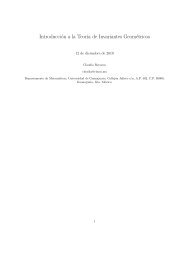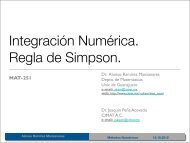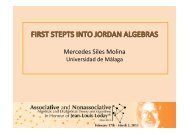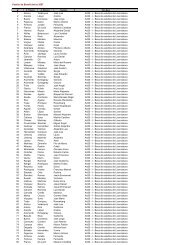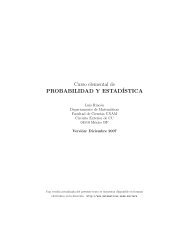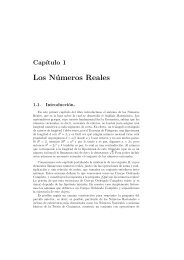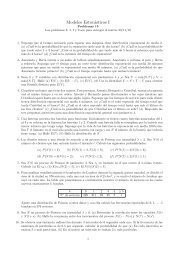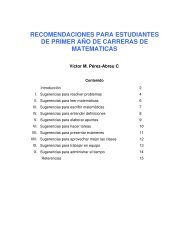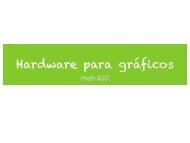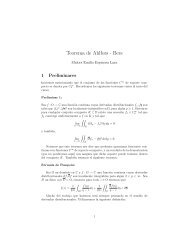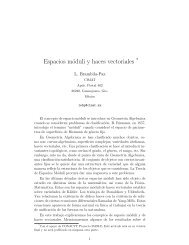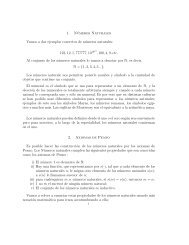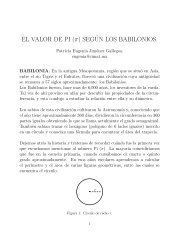Introduccion al uso de OpenCV (2) - Cimat
Introduccion al uso de OpenCV (2) - Cimat
Introduccion al uso de OpenCV (2) - Cimat
Create successful ePaper yourself
Turn your PDF publications into a flip-book with our unique Google optimized e-Paper software.
<strong>Introduccion</strong> <strong>al</strong> <strong>uso</strong> <strong>de</strong> <strong>OpenCV</strong> (2)<br />
Dr. J.B. Hayet<br />
CENTRO DE INVESTIGACIÓN EN MATEMÁTICAS<br />
Agosto 2007<br />
,<br />
J.B. Hayet <strong>OpenCV</strong> parte 2, Agosto 2007 1 / 64
Outline<br />
1 <strong>OpenCV</strong> : funcion<strong>al</strong>ida<strong>de</strong>s <strong>de</strong> procesamiento <strong>de</strong> imágenes<br />
2 <strong>OpenCV</strong> : funcion<strong>al</strong>ida<strong>de</strong>s <strong>de</strong> geometría<br />
3 <strong>OpenCV</strong> y IPP<br />
4 Usando scripts : los wrappers Python<br />
5 Tricks<br />
,<br />
J.B. Hayet <strong>OpenCV</strong> parte 2, Agosto 2007 2 / 64
Procesamiento <strong>de</strong> imágenes con <strong>OpenCV</strong><br />
<strong>OpenCV</strong> contiene un gran numero <strong>de</strong> funcion<strong>al</strong>ida<strong>de</strong>s entre las mas<br />
clásicas <strong>de</strong> procesamiento <strong>de</strong> imágenes : filtrados, <strong>de</strong>rivación,<br />
operadores morfológicos. . .<br />
Recorrer la documentación para verificar si una función dada esta<br />
implementada o no.<br />
,<br />
J.B. Hayet <strong>OpenCV</strong> parte 2, Agosto 2007 3 / 64
Image Processing<br />
Gradients, Edges and Corners<br />
Sampling, Interpolation and Geometric<strong>al</strong> Transforms<br />
Morphologic<strong>al</strong> Operations<br />
Filters and Color Conversion<br />
Pyramids and the Applications<br />
Image Segmentation, Connected Components and Contour<br />
Retriev<strong>al</strong><br />
Image and Contour Moments<br />
Speci<strong>al</strong> Image Transforms<br />
Histograms<br />
Matching<br />
,<br />
J.B. Hayet <strong>OpenCV</strong> parte 2, Agosto 2007 4 / 64
Structur<strong>al</strong> An<strong>al</strong>ysis<br />
Contour Processing<br />
Computation<strong>al</strong> Geometry<br />
Planar Subdivisions<br />
,<br />
J.B. Hayet <strong>OpenCV</strong> parte 2, Agosto 2007 5 / 64
Motion An<strong>al</strong>ysis and Object Tracking<br />
Accumulation of Background Statistics<br />
Motion Templates<br />
Object Tracking<br />
Optic<strong>al</strong> Flow<br />
Estimators<br />
,<br />
J.B. Hayet <strong>OpenCV</strong> parte 2, Agosto 2007 6 / 64
Pattern Recognition<br />
Object Detection<br />
,<br />
J.B. Hayet <strong>OpenCV</strong> parte 2, Agosto 2007 7 / 64
Camera C<strong>al</strong>ibration and 3D Reconstruction<br />
Camera C<strong>al</strong>ibration<br />
Pose Estimation<br />
Epipolar Geometry<br />
,<br />
J.B. Hayet <strong>OpenCV</strong> parte 2, Agosto 2007 8 / 64
<strong>OpenCV</strong> : funcion<strong>al</strong>ida<strong>de</strong>s <strong>de</strong> procesamiento <strong>de</strong> imágenes<br />
Outline<br />
1 <strong>OpenCV</strong> : funcion<strong>al</strong>ida<strong>de</strong>s <strong>de</strong> procesamiento <strong>de</strong> imágenes<br />
2 <strong>OpenCV</strong> : funcion<strong>al</strong>ida<strong>de</strong>s <strong>de</strong> geometría<br />
3 <strong>OpenCV</strong> y IPP<br />
4 Usando scripts : los wrappers Python<br />
5 Tricks<br />
,<br />
J.B. Hayet <strong>OpenCV</strong> parte 2, Agosto 2007 9 / 64
<strong>OpenCV</strong> : funcion<strong>al</strong>ida<strong>de</strong>s <strong>de</strong> procesamiento <strong>de</strong> imágenes<br />
Conversión entre espacios <strong>de</strong> color<br />
void c v C v t C o l o r ( const CvArr ∗ s r c , CvArr ∗ dst ,<br />
i n t co<strong>de</strong> ) ;<br />
Con el co<strong>de</strong> <strong>de</strong> la forma siguiente CV ESPA12ESPA2, don<strong>de</strong> ESPA1<br />
y ESPA2 pue<strong>de</strong>n ser entre : BGR, RGB, XYZ, YCrCb, HSV<br />
,<br />
J.B. Hayet <strong>OpenCV</strong> parte 2, Agosto 2007 10 / 64
<strong>OpenCV</strong> : funcion<strong>al</strong>ida<strong>de</strong>s <strong>de</strong> procesamiento <strong>de</strong> imágenes<br />
Umbr<strong>al</strong><br />
Umbr<strong>al</strong> :<br />
double c v T h r e s h o l d ( const CvArr ∗ s r c ,<br />
CvArr ∗ dst , double t h r e s h o l d ,<br />
double max v<strong>al</strong> , i n t t h r e s h t y p e ) ;<br />
,<br />
J.B. Hayet <strong>OpenCV</strong> parte 2, Agosto 2007 11 / 64
<strong>OpenCV</strong> : funcion<strong>al</strong>ida<strong>de</strong>s <strong>de</strong> procesamiento <strong>de</strong> imágenes<br />
Filtros<br />
void c v F i l t e r 2 D ( const CvArr ∗ s r c , CvArr ∗ dst ,<br />
const CvMat∗ k e r n e l ,<br />
CvPoint anchor=c v P o i n t ( −1 , −1));<br />
Ejemplo <strong>de</strong> <strong>uso</strong>:<br />
CvMat∗ k e r n e l = cvCreateMat ( 1 1 , 1 1 , CV 32F ) ;<br />
cvSet ( k e r n e l ,<br />
c v S c a l a r ( 1 . / ( k e r n e l −>rows ∗ k e r n e l −>c o l s ) ) ) ;<br />
c v F i l t e r 2 D (A, B, k e r n e l ,<br />
c v P o i n t ( k e r n e l −>c o l s /2 ,<br />
k e r n e l −>rows / 2 ) ) ;<br />
,<br />
J.B. Hayet <strong>OpenCV</strong> parte 2, Agosto 2007 12 / 64
<strong>OpenCV</strong> : funcion<strong>al</strong>ida<strong>de</strong>s <strong>de</strong> procesamiento <strong>de</strong> imágenes<br />
Filtros : smoothing<br />
Una función <strong>de</strong> smoothing mas especi<strong>al</strong>izada que cvFilter2D :<br />
void cvSmooth ( const CvArr ∗ s r c , CvArr ∗ dst ,<br />
i n t smoothtype=CV GAUSSIAN ,<br />
i n t param1=3, i n t param2=0,<br />
double param3=0, double param4=0 ) ;<br />
,<br />
J.B. Hayet <strong>OpenCV</strong> parte 2, Agosto 2007 13 / 64
<strong>OpenCV</strong> : funcion<strong>al</strong>ida<strong>de</strong>s <strong>de</strong> procesamiento <strong>de</strong> imágenes<br />
Filtros : smoothing<br />
Tipos <strong>de</strong> filtraje con cvSmooth:<br />
# CV BLUR NO SCALE<br />
# CV BLUR ( s i m p l e b l u r )<br />
# CV GAUSSIAN ( g a u s s i a n b l u r )<br />
# CV MEDIAN ( median b l u r )<br />
# CV BILATERAL<br />
,<br />
J.B. Hayet <strong>OpenCV</strong> parte 2, Agosto 2007 14 / 64
<strong>OpenCV</strong> : funcion<strong>al</strong>ida<strong>de</strong>s <strong>de</strong> procesamiento <strong>de</strong> imágenes<br />
Derivadas y bordos<br />
Sobel, Canny<br />
void c v S o b e l ( const CvArr ∗ s r c , CvArr ∗ dst ,<br />
i n t xor<strong>de</strong>r , i n t yor<strong>de</strong>r ,<br />
i n t a p e r t u r e s i z e =3);<br />
void cvCanny ( const CvArr ∗ image , CvArr ∗ edges ,<br />
double t h r e s h o l d 1 ,<br />
double t h r e s h o l d 2 , i n t a p e r t u r e s i z e =3);<br />
,<br />
J.B. Hayet <strong>OpenCV</strong> parte 2, Agosto 2007 15 / 64
<strong>OpenCV</strong> : funcion<strong>al</strong>ida<strong>de</strong>s <strong>de</strong> procesamiento <strong>de</strong> imágenes<br />
Derivadas y bordos<br />
,<br />
J.B. Hayet <strong>OpenCV</strong> parte 2, Agosto 2007 16 / 64
<strong>OpenCV</strong> : funcion<strong>al</strong>ida<strong>de</strong>s <strong>de</strong> procesamiento <strong>de</strong> imágenes<br />
Derivadas y bordos<br />
,<br />
J.B. Hayet <strong>OpenCV</strong> parte 2, Agosto 2007 17 / 64
<strong>OpenCV</strong> : funcion<strong>al</strong>ida<strong>de</strong>s <strong>de</strong> procesamiento <strong>de</strong> imágenes<br />
Laplaciano<br />
,<br />
J.B. Hayet <strong>OpenCV</strong> parte 2, Agosto 2007 18 / 64
<strong>OpenCV</strong> : funcion<strong>al</strong>ida<strong>de</strong>s <strong>de</strong> procesamiento <strong>de</strong> imágenes<br />
Imágenes integr<strong>al</strong>es<br />
Pue<strong>de</strong>n revelarse muy útiles para cálculos muy rápidos <strong>de</strong> sumas<br />
sobre ventanas (las Haar wavelets por ejemplo).<br />
void c v I n t e g r a l ( const CvArr ∗ image , CvArr ∗ sum ,<br />
CvArr ∗ sqsum=NULL , CvArr ∗ t i l t e d s u m=NULL ) ;<br />
,<br />
J.B. Hayet <strong>OpenCV</strong> parte 2, Agosto 2007 19 / 64
<strong>OpenCV</strong> : funcion<strong>al</strong>ida<strong>de</strong>s <strong>de</strong> procesamiento <strong>de</strong> imágenes<br />
Pirámi<strong>de</strong>s gausianas<br />
Muy útiles para razonamiento multi-esc<strong>al</strong>a :<br />
Down-sampling y filtrado gausiano :<br />
void cvPyrDown ( const CvArr ∗ s r c , CvArr ∗ dst ,<br />
i n t f i l t e r =CV GAUSSIAN 5x5 ) ;<br />
Up-sampling :<br />
void cvPyrUp ( const CvArr ∗ s r c , CvArr ∗ dst ,<br />
i n t f i l t e r =CV GAUSSIAN 5x5 ) ;<br />
,<br />
J.B. Hayet <strong>OpenCV</strong> parte 2, Agosto 2007 20 / 64
<strong>OpenCV</strong> : funcion<strong>al</strong>ida<strong>de</strong>s <strong>de</strong> procesamiento <strong>de</strong> imágenes<br />
Pirámi<strong>de</strong>s gausianas<br />
,<br />
J.B. Hayet <strong>OpenCV</strong> parte 2, Agosto 2007 21 / 64
<strong>OpenCV</strong> : funcion<strong>al</strong>ida<strong>de</strong>s <strong>de</strong> procesamiento <strong>de</strong> imágenes<br />
Morfología matemática<br />
Flexibilidad en la <strong>de</strong>finición <strong>de</strong>l elemento estructurante<br />
I p l C o n v K e r n e l ∗ c v C r e a t e S t r u c t u r i n g E l e m e n t E x (<br />
i n t c o l s , i n t rows ,<br />
i n t anchx , i n t anchy ,<br />
i n t shape ,<br />
i n t ∗ v a l u e s=NULL ) ;<br />
c v R e l e a s e S t r u c t u r i n g E l e m e n t ( I p l C o n v K e r n e l ∗∗ e l ) ;<br />
Elemento no necesariamente simétrico (anchor)<br />
,<br />
J.B. Hayet <strong>OpenCV</strong> parte 2, Agosto 2007 22 / 64
<strong>OpenCV</strong> : funcion<strong>al</strong>ida<strong>de</strong>s <strong>de</strong> procesamiento <strong>de</strong> imágenes<br />
Morfología matemática<br />
Formas soportadas<br />
CV SHAPE RECT<br />
CV SHAPE CROSS<br />
CV SHAPE ELLIPSE<br />
CV SHAPE CUSTOM<br />
En caso <strong>de</strong> CUSTOM, se usan los v<strong>al</strong>ores <strong>de</strong>l arreglo v<strong>al</strong>ues<br />
,<br />
J.B. Hayet <strong>OpenCV</strong> parte 2, Agosto 2007 23 / 64
<strong>OpenCV</strong> : funcion<strong>al</strong>ida<strong>de</strong>s <strong>de</strong> procesamiento <strong>de</strong> imágenes<br />
Morfología matemática<br />
Operadores básicos :<br />
void cvEro<strong>de</strong> ( const CvArr ∗ s r c , CvArr ∗ dst ,<br />
I p l C o n v K e r n e l ∗ element=NULL , i n t i t e r a t i o n s =1);<br />
void c v D i l a t e ( const CvArr ∗ s r c , CvArr ∗ dst ,<br />
I p l C o n v K e r n e l ∗ element=NULL , i n t i t e r a t i o n s =1);<br />
,<br />
J.B. Hayet <strong>OpenCV</strong> parte 2, Agosto 2007 24 / 64
<strong>OpenCV</strong> : funcion<strong>al</strong>ida<strong>de</strong>s <strong>de</strong> procesamiento <strong>de</strong> imágenes<br />
Morfología matemática<br />
,<br />
J.B. Hayet <strong>OpenCV</strong> parte 2, Agosto 2007 25 / 64
<strong>OpenCV</strong> : funcion<strong>al</strong>ida<strong>de</strong>s <strong>de</strong> procesamiento <strong>de</strong> imágenes<br />
Puntos <strong>de</strong> interés<br />
Todos los métodos implementados son basados en la matriz <strong>de</strong><br />
autocorrelación :<br />
void cvCornerMinEigenV<strong>al</strong> ( const CvArr ∗ img , CvArr ∗ eig ,<br />
i n t b l o c k s i z e , i n t a p s i z e =3);<br />
void c v C o r n e r H a r r i s ( const CvArr ∗ image , CvArr ∗ dst ,<br />
i n t b l o c k s i z e , i n t a p s i z e =3,<br />
double k =0.04 ) ;<br />
void cvFindCornerSubPix ( const CvArr ∗ img ,<br />
CvPoint2D32f ∗ c o r n e r s ,<br />
i n t count ,<br />
CvSize win , CvSize z e r o z o n e ,<br />
C v T e r m C r i t e r i a c r i t e r i a ) ;<br />
,<br />
J.B. Hayet <strong>OpenCV</strong> parte 2, Agosto 2007 26 / 64
<strong>OpenCV</strong> : funcion<strong>al</strong>ida<strong>de</strong>s <strong>de</strong> procesamiento <strong>de</strong> imágenes<br />
LK tracking<br />
Método <strong>de</strong> Lucas-Kana<strong>de</strong> para el seguimiento <strong>de</strong> puntos <strong>de</strong> interés<br />
(funciona bien para puntos <strong>de</strong> tipo esquinas, <strong>de</strong>tectados por los<br />
operadores vistos antes)<br />
void cvC<strong>al</strong>cOptic<strong>al</strong>FlowLK ( const CvArr ∗ prev ,<br />
const CvArr ∗ c u r r ,<br />
CvSize w i n s i z e ,<br />
CvArr ∗ v e l x , CvArr ∗ v e l y ) ;<br />
,<br />
J.B. Hayet <strong>OpenCV</strong> parte 2, Agosto 2007 27 / 64
<strong>OpenCV</strong> : funcion<strong>al</strong>ida<strong>de</strong>s <strong>de</strong> procesamiento <strong>de</strong> imágenes<br />
LK tracking<br />
,<br />
J.B. Hayet <strong>OpenCV</strong> parte 2, Agosto 2007 28 / 64
<strong>OpenCV</strong> : funcion<strong>al</strong>ida<strong>de</strong>s <strong>de</strong> procesamiento <strong>de</strong> imágenes<br />
Histogramas<br />
type<strong>de</strong>f s t r u c t CvHistogram {<br />
i n t type ;<br />
CvArr ∗ b i n s ;<br />
f l o a t t h r e s h [ CV MAX DIM ] [ 2 ] ; /∗ uniform h i s t . ∗/<br />
f l o a t ∗∗ t h r e s h 2 ; /∗ non−uniform h i s t . ∗/<br />
CvMatND mat ; /∗ m a t r i x hea<strong>de</strong>r f o r a r r a y h i s t . ∗/<br />
} CvHistogram ;<br />
,<br />
J.B. Hayet <strong>OpenCV</strong> parte 2, Agosto 2007 29 / 64
<strong>OpenCV</strong> : funcion<strong>al</strong>ida<strong>de</strong>s <strong>de</strong> procesamiento <strong>de</strong> imágenes<br />
Histogramas<br />
CvHistogram ∗ c v C r e a t e H i s t ( i n t dims , i n t ∗ s i z e s ,<br />
i n t type ,<br />
f l o a t ∗∗ r a n g e s=NULL ,<br />
i n t uniform=1 ) ;<br />
void c v R e l e a s e H i s t ( CvHistogram ∗∗ h i s t ) ;<br />
void c v N o r m a l i z e H i s t ( CvHistogram ∗ h i s t , double f a c t o r<br />
void c v C a l c H i s t ( I p l I m a g e ∗∗ image , CvHistogram ∗ h i s t ,<br />
i n t accumulate =0, const CvArr ∗ mask=N<br />
#<strong>de</strong>fine cvQueryHistV<strong>al</strong>ue 1D ( h i s t , i d x 0 ) \<br />
cvGetRe<strong>al</strong>1D ( ( h i s t )−>bins , ( i d x 0 ) )<br />
#<strong>de</strong>fine cvQueryHistV<strong>al</strong>ue 2D ( h i s t , idx0 , i d x 1 ) \<br />
cvGetRe<strong>al</strong>2D ( ( h i s t )−>bins , ( i d x 0 ) , ( i d x 1 ) )<br />
#<strong>de</strong>fine cvQueryHistV<strong>al</strong>ue 3D ( h i s t , idx0 , idx1 , i d x 2 )<br />
cvGetRe<strong>al</strong>3D ( ( h i s t )−>bins , ( i d x 0 ) , ( i d x 1 ) , ( i d x 2 )<br />
,<br />
J.B. Hayet <strong>OpenCV</strong> parte 2, Agosto 2007 30 / 64
<strong>OpenCV</strong> : funcion<strong>al</strong>ida<strong>de</strong>s <strong>de</strong> procesamiento <strong>de</strong> imágenes<br />
Histogramas : ejemplo<br />
,<br />
J.B. Hayet <strong>OpenCV</strong> parte 2, Agosto 2007 31 / 64
<strong>OpenCV</strong> : funcion<strong>al</strong>ida<strong>de</strong>s <strong>de</strong> procesamiento <strong>de</strong> imágenes<br />
Histogramas : comparación<br />
Varias métricas para histogramas :<br />
double cvCompareHist ( const CvHistogram ∗ h i s t 1 ,<br />
const CvHistogram ∗ h i s t 2 ,<br />
i n t method ) ;<br />
CV COMP CORREL<br />
CV COMP CHISQR<br />
CV COMP INTERSECT<br />
CV COMP BHATTACHARYYA<br />
,<br />
J.B. Hayet <strong>OpenCV</strong> parte 2, Agosto 2007 32 / 64
<strong>OpenCV</strong> : funcion<strong>al</strong>ida<strong>de</strong>s <strong>de</strong> procesamiento <strong>de</strong> imágenes<br />
Transformada <strong>de</strong> Hough<br />
Método clásico <strong>de</strong> acumulación para la <strong>de</strong>tección <strong>de</strong> objetos<br />
parametrizados :<br />
CvSeq∗ cvHoughLines2 ( CvArr ∗ img , void ∗ l i n e s t o r a g e ,<br />
i n t method ,<br />
double rho , double theta ,<br />
i n t t h r e s h ,<br />
double par1 =0, double par2 =0);<br />
CvSeq∗ c v H o u g h C i r c l e s ( CvArr ∗ img , void ∗ c i r c s t o r a g e ,<br />
i n t method ,<br />
double dp , double m i n d i s t ,<br />
double par1 =100 ,<br />
double par2 =100 ,<br />
i n t m i n r a d i u s =0,<br />
i n t m a x r a d i u s =0);<br />
,<br />
J.B. Hayet <strong>OpenCV</strong> parte 2, Agosto 2007 33 / 64
<strong>OpenCV</strong> : funcion<strong>al</strong>ida<strong>de</strong>s <strong>de</strong> procesamiento <strong>de</strong> imágenes<br />
Transformada <strong>de</strong> Hough : lineas rectas<br />
,<br />
J.B. Hayet <strong>OpenCV</strong> parte 2, Agosto 2007 34 / 64
<strong>OpenCV</strong> : funcion<strong>al</strong>ida<strong>de</strong>s <strong>de</strong> procesamiento <strong>de</strong> imágenes<br />
Transformada <strong>de</strong> Hough : círculos<br />
,<br />
J.B. Hayet <strong>OpenCV</strong> parte 2, Agosto 2007 35 / 64
<strong>OpenCV</strong> : funcion<strong>al</strong>ida<strong>de</strong>s <strong>de</strong> procesamiento <strong>de</strong> imágenes<br />
Detección <strong>de</strong> caras<br />
Un ejemplo que viene por <strong>de</strong>fault con <strong>OpenCV</strong>:<br />
,<br />
J.B. Hayet <strong>OpenCV</strong> parte 2, Agosto 2007 36 / 64
<strong>OpenCV</strong> : funcion<strong>al</strong>ida<strong>de</strong>s <strong>de</strong> procesamiento <strong>de</strong> imágenes<br />
Ada-boost con Haar wavelets<br />
,<br />
J.B. Hayet <strong>OpenCV</strong> parte 2, Agosto 2007 37 / 64
<strong>OpenCV</strong> : funcion<strong>al</strong>ida<strong>de</strong>s <strong>de</strong> procesamiento <strong>de</strong> imágenes<br />
Ada-boost con Haar wavelets<br />
La i<strong>de</strong>a es hacer <strong>de</strong>tección <strong>de</strong> objetos <strong>de</strong> una clase dada usando una<br />
cascada <strong>de</strong> clasificadores débiles (típicamente, por una <strong>de</strong> las Haar<br />
wavelets)<br />
CvSeq∗ c v H a a r D e t e c t O b j e c t s ( const CvArr ∗ image ,<br />
C v H a a r C l a s s i f i e r C a s c a d e ∗ c<br />
CvMemStorage∗ s t o r a g e ,<br />
double s c a l e f a c t o r =1.1 ,<br />
i n t m i n n e i g h b o r s =3,<br />
i n t f l a g s =0,<br />
CvSize m i n s i z e=c v S i z e ( 0 , 0 )<br />
,<br />
J.B. Hayet <strong>OpenCV</strong> parte 2, Agosto 2007 38 / 64
Outline<br />
<strong>OpenCV</strong> : funcion<strong>al</strong>ida<strong>de</strong>s <strong>de</strong> geometría<br />
1 <strong>OpenCV</strong> : funcion<strong>al</strong>ida<strong>de</strong>s <strong>de</strong> procesamiento <strong>de</strong> imágenes<br />
2 <strong>OpenCV</strong> : funcion<strong>al</strong>ida<strong>de</strong>s <strong>de</strong> geometría<br />
3 <strong>OpenCV</strong> y IPP<br />
4 Usando scripts : los wrappers Python<br />
5 Tricks<br />
,<br />
J.B. Hayet <strong>OpenCV</strong> parte 2, Agosto 2007 39 / 64
C<strong>al</strong>ibración<br />
<strong>OpenCV</strong> : funcion<strong>al</strong>ida<strong>de</strong>s <strong>de</strong> geometría<br />
Por el momento, viene implementado un metodo clásico basado en<br />
motivo 3D (Tsai) para estimar parametros intrinsecos y extrinsecos.<br />
A<strong>de</strong>mas tiene las herramientas necesarias para usarla muy<br />
simplemente en casos planos (<strong>de</strong>tección <strong>de</strong> motivos <strong>de</strong> tipo ajedrez)<br />
,<br />
J.B. Hayet <strong>OpenCV</strong> parte 2, Agosto 2007 40 / 64
C<strong>al</strong>ibración<br />
<strong>OpenCV</strong> : funcion<strong>al</strong>ida<strong>de</strong>s <strong>de</strong> geometría<br />
Función <strong>de</strong> c<strong>al</strong>ibración :<br />
void c v C a l i b r a t e C a m e r a 2 ( const CvMat∗ o b j e c t p o i n t s ,<br />
const CvMat∗ i m a g e p o i n t s ,<br />
const CvMat∗ p o i n t c o u n t s ,<br />
CvSize i m a g e s i z e ,<br />
CvMat∗ i n t r i n s i c m a t r i x ,<br />
CvMat∗ d i s t o r t i o n c o e f f s ,<br />
CvMat∗ r o t v e c t o r s=NULL ,<br />
CvMat∗ t r a n s v e c t o r s=NULL ,<br />
i n t f l a g s =0 ) ;<br />
,<br />
J.B. Hayet <strong>OpenCV</strong> parte 2, Agosto 2007 41 / 64
C<strong>al</strong>ibración<br />
<strong>OpenCV</strong> : funcion<strong>al</strong>ida<strong>de</strong>s <strong>de</strong> geometría<br />
,<br />
J.B. Hayet <strong>OpenCV</strong> parte 2, Agosto 2007 42 / 64
<strong>OpenCV</strong> : funcion<strong>al</strong>ida<strong>de</strong>s <strong>de</strong> geometría<br />
C<strong>al</strong>ibración: distorsión radi<strong>al</strong> y tangenci<strong>al</strong><br />
Corrección <strong>de</strong> la distorsión :<br />
void c v U n d i s t o r t 2 ( const CvArr ∗ s r c , CvArr ∗ dst ,<br />
const CvMat∗ i n t r i n s i c m a t r i x ,<br />
const CvMat∗ d i s t o r t i o n c o e f f s ) ;<br />
,<br />
J.B. Hayet <strong>OpenCV</strong> parte 2, Agosto 2007 43 / 64
<strong>OpenCV</strong> : funcion<strong>al</strong>ida<strong>de</strong>s <strong>de</strong> geometría<br />
C<strong>al</strong>ibración : distorsión radi<strong>al</strong> y tangenci<strong>al</strong><br />
,<br />
J.B. Hayet <strong>OpenCV</strong> parte 2, Agosto 2007 44 / 64
<strong>OpenCV</strong> : funcion<strong>al</strong>ida<strong>de</strong>s <strong>de</strong> geometría<br />
C<strong>al</strong>culo <strong>de</strong> transformaciones geométricas<br />
void cvFindHomography ( const CvMat∗ s r c p o i n t s ,<br />
const CvMat∗ d s t p o i n t s ,<br />
CvMat∗ homography ) ;<br />
i n t cvFindFundament<strong>al</strong>Mat ( const CvMat∗ p o i n t s 1 ,<br />
const CvMat∗ p o i n t s 2 ,<br />
CvMat∗ f u n d a m e n t a l m a t r i x ,<br />
i n t method=CV FM RANSAC ,<br />
double param1 =1. ,<br />
double param2 =0.99 ,<br />
CvMat∗ s t a t u s=NULL ) ;<br />
,<br />
J.B. Hayet <strong>OpenCV</strong> parte 2, Agosto 2007 45 / 64
<strong>OpenCV</strong> : funcion<strong>al</strong>ida<strong>de</strong>s <strong>de</strong> geometría<br />
Estimación <strong>de</strong> la pose (cámara c<strong>al</strong>ibrada)<br />
void cvPOSIT ( CvPOSITObject∗ p o s i t o b j e c t ,<br />
CvPoint2D32f ∗ i m a g e p o i n t s ,<br />
double f o c a l l e n g t h ,<br />
C v T e r m C r i t e r i a c r i t e r i a ,<br />
CvMatr32f r o t a t i o n m a t r i x ,<br />
CvVect32f t r a n s l a t i o n v e c t o r ) ;<br />
La estructura CvPOSITObject contiene los puntos 3D <strong>de</strong>l objeto<br />
sobre el cu<strong>al</strong> nos loc<strong>al</strong>izamos.<br />
,<br />
J.B. Hayet <strong>OpenCV</strong> parte 2, Agosto 2007 46 / 64
<strong>OpenCV</strong> : funcion<strong>al</strong>ida<strong>de</strong>s <strong>de</strong> geometría<br />
Geometría epipolar<br />
Lineas epipolares correspondientes <strong>de</strong> unos puntos 2D<br />
void c v C o m p u t e C o r r e s p o n d E p i l i n e s (<br />
const CvMat∗ p o i n t s ,<br />
i n t which image ,<br />
const CvMat∗ f u n d a m e n t a l m a t r i x ,<br />
CvMat∗ c o r r e s p o n d e n t l i n e s ) ;<br />
,<br />
J.B. Hayet <strong>OpenCV</strong> parte 2, Agosto 2007 47 / 64
Outline<br />
<strong>OpenCV</strong> y IPP<br />
1 <strong>OpenCV</strong> : funcion<strong>al</strong>ida<strong>de</strong>s <strong>de</strong> procesamiento <strong>de</strong> imágenes<br />
2 <strong>OpenCV</strong> : funcion<strong>al</strong>ida<strong>de</strong>s <strong>de</strong> geometría<br />
3 <strong>OpenCV</strong> y IPP<br />
4 Usando scripts : los wrappers Python<br />
5 Tricks<br />
,<br />
J.B. Hayet <strong>OpenCV</strong> parte 2, Agosto 2007 48 / 64
IPP<br />
<strong>OpenCV</strong> y IPP<br />
IPP (Integrated Performance Primitives) es una parte <strong>de</strong> las<br />
bibliotecas <strong>de</strong> computo <strong>de</strong>sarrolladas por Intel para aprovechar<br />
<strong>de</strong> las características mas avanzadas <strong>de</strong> sus procesadores<br />
(SIMD)<br />
Provee funciones soportando el multi-core, y muy bien<br />
optimizadas<br />
Soporte 64 bits<br />
,<br />
J.B. Hayet <strong>OpenCV</strong> parte 2, Agosto 2007 49 / 64
<strong>OpenCV</strong> y IPP<br />
IPP : ¿ dón<strong>de</strong> esta la magia ?<br />
Funcion<strong>al</strong>idad SIMD (single instruction, multiple data) :<br />
registros <strong>de</strong> 64 o 128 bits.<br />
Un registro <strong>de</strong> 128 bits pue<strong>de</strong> contener 4 int, 4 float<br />
Intel: MMX y luego SSE (Streaming SIMD extension)<br />
En gener<strong>al</strong>, adaptado a toda clase <strong>de</strong> problemas vectorizables<br />
(muchos tratamientos loc<strong>al</strong>es in<strong>de</strong>pendientes<br />
Cuidado <strong>al</strong> <strong>al</strong>ineamiento <strong>de</strong> los datos<br />
,<br />
J.B. Hayet <strong>OpenCV</strong> parte 2, Agosto 2007 50 / 64
IPP: Scope<br />
<strong>OpenCV</strong> y IPP<br />
Vi<strong>de</strong>o encoding/<strong>de</strong>co- Audio <strong>de</strong>coding/en- Compresión <strong>de</strong> datos<br />
dingcoding<br />
Procesamiento <strong>de</strong> Vision Procesamiento <strong>de</strong><br />
imagenes<br />
señ<strong>al</strong><br />
Vectores y matrices JPEG/JPEG2000 Criptografia<br />
Procesamiento <strong>de</strong>l hablar<br />
Rendido ...<br />
,<br />
J.B. Hayet <strong>OpenCV</strong> parte 2, Agosto 2007 51 / 64
Ejemplo<br />
<strong>OpenCV</strong> y IPP<br />
I p p S t a t u s ippiRGBToGray (<br />
const Ipp∗ pSrc , i n t s r c S t e p ,<br />
Ipp∗ pDst , i n t dstStep , I p p i S i z e r o i S i z e ) ;<br />
V<strong>al</strong>ores <strong>de</strong> mod:<br />
8u C3C1R 16u C3C1R 16 s C3C1R 32 f C3C1R<br />
8u AC4C1R 16u AC4C1R 16s AC4C1R 32 f AC4C1R<br />
,<br />
J.B. Hayet <strong>OpenCV</strong> parte 2, Agosto 2007 52 / 64
<strong>OpenCV</strong> y IPP<br />
Cuanto se mejoran las performancias<br />
Tipo <strong>de</strong> funcion<strong>al</strong>idad Incremento <strong>de</strong> velocidad<br />
Pirami<strong>de</strong>s gausianas ≈ 3×<br />
Morfología ≈ 3 − 7×<br />
Convolucion linear ≈ 2 − 8×<br />
Conversion color ≈ 1 − 3×<br />
Detección <strong>de</strong> esquinas ≈ 1.8×<br />
,<br />
J.B. Hayet <strong>OpenCV</strong> parte 2, Agosto 2007 53 / 64
IPP y <strong>OpenCV</strong><br />
<strong>OpenCV</strong> y IPP<br />
Llamadas a funciones están integradas a una gran parte <strong>de</strong><br />
<strong>OpenCV</strong><br />
Se <strong>de</strong>ci<strong>de</strong> en el tiempo <strong>de</strong> la ejecución si se usa o no IPP<br />
Para que se use, se necesita poner unas variables <strong>de</strong> entorno<br />
(<strong>de</strong> t<strong>al</strong> manera que las librerías <strong>de</strong> IPP estén en el path)<br />
,<br />
J.B. Hayet <strong>OpenCV</strong> parte 2, Agosto 2007 54 / 64
IPP y <strong>OpenCV</strong><br />
Verificar que sí se usa IPP:<br />
<strong>OpenCV</strong> y IPP<br />
const char ∗ p l u g i n i n f o= 0 ;<br />
cvGetModuleInfo (0 ,0 ,& p l u g i n i n f o ) ;<br />
i p p i s u s e d= ( p l u g i n i n f o != 0) &&<br />
s t r s t r ( p l u g i n i n f o , ”ipp” )!=0;<br />
Apagar el <strong>uso</strong> <strong>de</strong> IPP y ponerlo otra vez:<br />
cvUseOptimized ( 0 ) ; . . . cvUseOptimized ( 1 ) ;<br />
,<br />
J.B. Hayet <strong>OpenCV</strong> parte 2, Agosto 2007 55 / 64
Outline<br />
Usando scripts : los wrappers Python<br />
1 <strong>OpenCV</strong> : funcion<strong>al</strong>ida<strong>de</strong>s <strong>de</strong> procesamiento <strong>de</strong> imágenes<br />
2 <strong>OpenCV</strong> : funcion<strong>al</strong>ida<strong>de</strong>s <strong>de</strong> geometría<br />
3 <strong>OpenCV</strong> y IPP<br />
4 Usando scripts : los wrappers Python<br />
5 Tricks<br />
,<br />
J.B. Hayet <strong>OpenCV</strong> parte 2, Agosto 2007 56 / 64
Usando scripts : los wrappers Python<br />
Python y <strong>OpenCV</strong><br />
Uso <strong>de</strong> Python i<strong>de</strong><strong>al</strong> para prototipos, preparar <strong>de</strong>mos<br />
Wrappers generados automáticamente (SWIG)<br />
Inst<strong>al</strong>ado automáticamente (necesita SWIG)<br />
Memoria manejada automáticamente<br />
,<br />
J.B. Hayet <strong>OpenCV</strong> parte 2, Agosto 2007 57 / 64
Usando scripts : los wrappers Python<br />
Python y <strong>OpenCV</strong><br />
No hay IplImage acá, solo CvMat<br />
Iteratores<br />
x = cvCreateMat (m, n , type )<br />
f o r row i n x :<br />
# row i s same as t h a t r e t u r n e d by cvGetRow<br />
o :<br />
f o r c o l i n x . c o l r a n g e ( ) :<br />
# c o l i s same as t h a t r e t u r n e d by cvGetCol<br />
,<br />
J.B. Hayet <strong>OpenCV</strong> parte 2, Agosto 2007 58 / 64
Usando scripts : los wrappers Python<br />
Python y <strong>OpenCV</strong><br />
Aceso por el operador [], notaciones a la Matlab<br />
c o l = x [ : , i ]<br />
s l i c e = x [ 0 : 1 0 , 0 : 1 0 ]<br />
elem1 = x [ i , j ]<br />
elem2 = x [ i ] [ j ]<br />
x [ : , : ] = 1<br />
x [ 0 : 1 0 , i ] = [ 0 , 1 , 2 , 3 , 4 , 5 , 6 , 7 , 8 , 9 ]<br />
,<br />
J.B. Hayet <strong>OpenCV</strong> parte 2, Agosto 2007 59 / 64
Usando scripts : los wrappers Python<br />
Python y <strong>OpenCV</strong><br />
Información muy útil en cuanto a la interfase Python :<br />
http://opencvlibrary.sourceforge.net/PythonInterface<br />
,<br />
J.B. Hayet <strong>OpenCV</strong> parte 2, Agosto 2007 60 / 64
Outline<br />
Tricks<br />
1 <strong>OpenCV</strong> : funcion<strong>al</strong>ida<strong>de</strong>s <strong>de</strong> procesamiento <strong>de</strong> imágenes<br />
2 <strong>OpenCV</strong> : funcion<strong>al</strong>ida<strong>de</strong>s <strong>de</strong> geometría<br />
3 <strong>OpenCV</strong> y IPP<br />
4 Usando scripts : los wrappers Python<br />
5 Tricks<br />
,<br />
J.B. Hayet <strong>OpenCV</strong> parte 2, Agosto 2007 61 / 64
Uso <strong>de</strong> la memoria<br />
Tricks<br />
La memoria esta manejada ”à la C”: cuidado <strong>de</strong> bien liberar los<br />
espacios reservados por las funciones <strong>de</strong> tipo Create o Clone.<br />
c v R e l e a s e I m a g e<br />
cvReleaseMat<br />
. . .<br />
,<br />
J.B. Hayet <strong>OpenCV</strong> parte 2, Agosto 2007 62 / 64
Tricks<br />
Soporte <strong>de</strong> funciones en sitio<br />
Checar en la documentacion si la funcion que se usa soporta un<br />
procesamiento en sitio (dst=src). Una mayoría <strong>de</strong> funciones sí lo<br />
soportan.<br />
,<br />
J.B. Hayet <strong>OpenCV</strong> parte 2, Agosto 2007 63 / 64
Alineación <strong>de</strong> datos<br />
Tricks<br />
Para optimizar el tratamiento <strong>de</strong> los datos, es mejor <strong>al</strong>inear las lineas<br />
sobre 4 o 8 octetos (es automático con funciones <strong>de</strong> tipo create)<br />
,<br />
J.B. Hayet <strong>OpenCV</strong> parte 2, Agosto 2007 64 / 64



